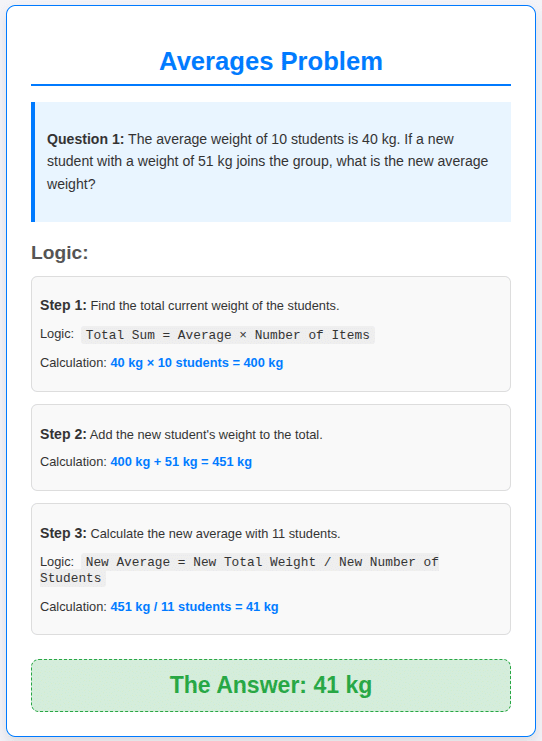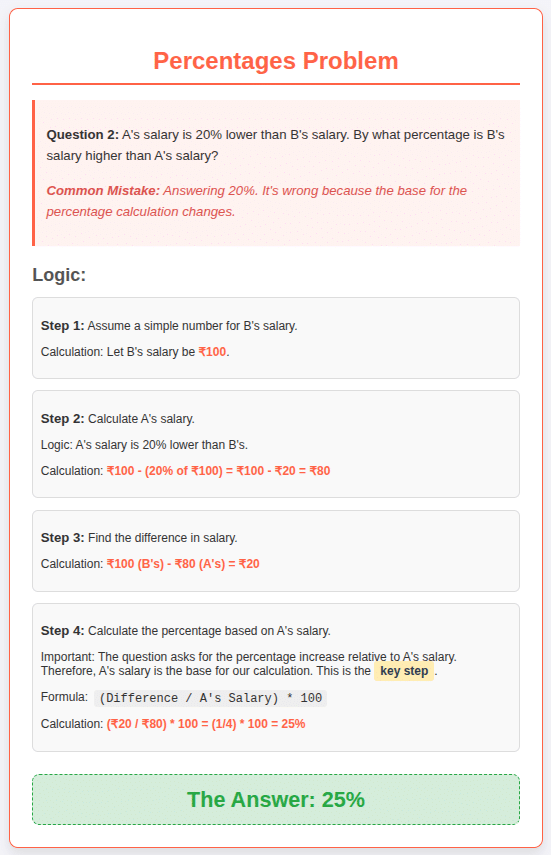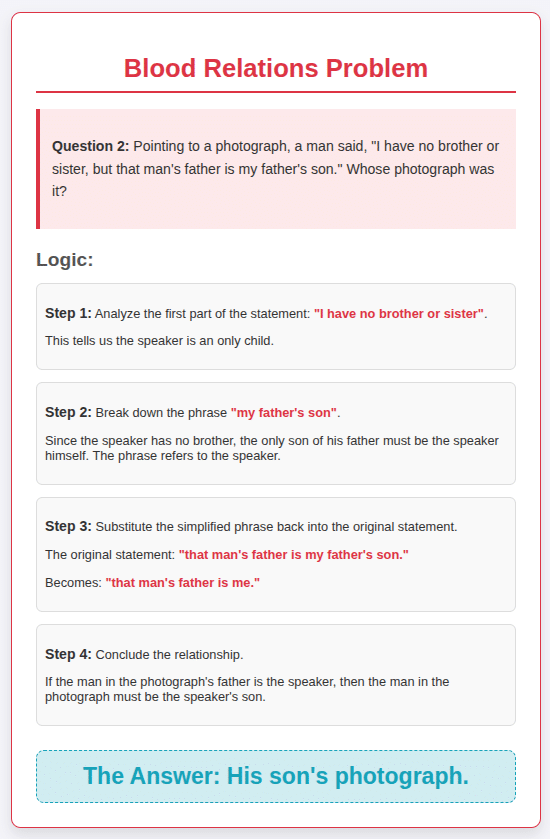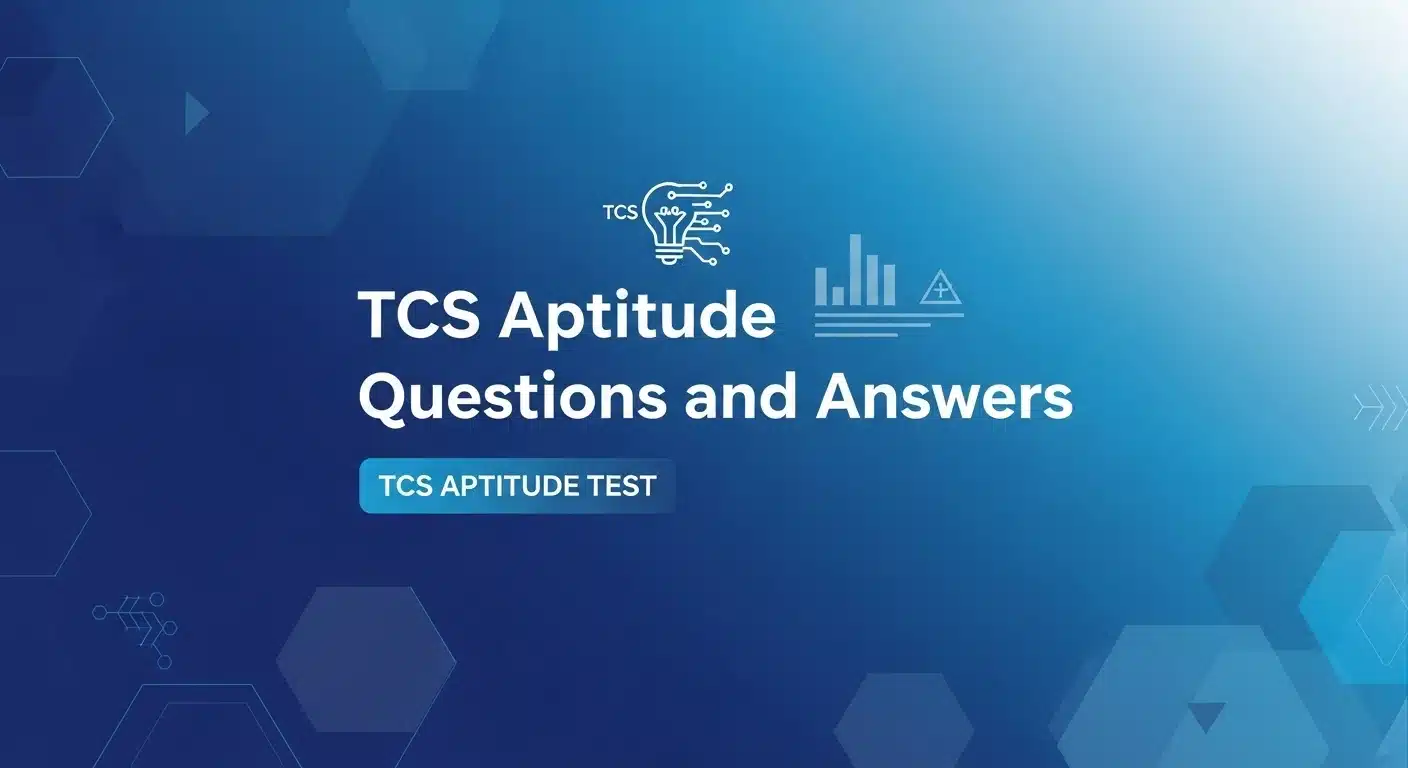TCS aptitude tests your ability to think critically, not just memorize formulas. This guide breaks down the test's pattern, covering key concepts from quantitative aptitude to logical reasoning and coding. Master the basics, practice consistently, and you'll be ready to tackle the test with confidence.
The TCS Aptitude test usually covers the following:
- Quantitative Aptitude Questions
- Logical Reasoning Questions
- Verbal Ability Questions
- Coding Questions
Quantitative Aptitude Questions
This section is designed to filter out people who can't handle basic math under pressure. It's not about complex calculus. It's about speed and accuracy on fundamentals. Get these topics down cold.
Key Topics:
- Averages
- Percentages
- Profit and Loss
- Time, Speed, and Distance
- Time and Work
- Permutations and Combinations
- Probability
- Number System
Let's break down some questions.
Question 1: Averages
The Problem: The average weight of 10 students is 40 kg. If a new student with a weight of 51 kg joins the group, what is the new average weight?

Don't Panic. Here's the Logic:
- Find the total current weight. Average = Total Sum / Number of Items. So, Total Sum = Average * Number of Items.
- Calculate it: Total weight = 40 kg * 10 students = 400 kg.
- Add the new student's weight. New total weight = 400 kg + 51 kg = 451 kg.
- Calculate the new average. Now there are 11 students. New Average = 451 kg / 11 students.
The Answer: 41 kg.
Why this is a good question: It tests two steps. First, understanding what 'average' means (the total sum), and second, correctly updating that average.
Read: General Quantitative Aptitude Questions and Answers
Question 2: Percentages
The Problem: A's salary is 20% lower than B's salary. By what percentage is B's salary higher than A's salary?
Common Mistake: Answering 20%. It's wrong. The base of the percentage calculation changes.

Here's the Logic:
- Assume a simple number for B's salary. Let's say B earns ₹100. This makes the math easy.
- Calculate A's salary. A's salary is 20% lower than B's. So, A's salary = ₹100 - (20% of ₹100) = ₹100 - ₹20 = ₹80.
- Now, calculate the difference. B's salary is ₹100, A's is ₹80. The difference is ₹20.
- The important part: The question asks "by what percentage is B's salary higher than A's". This means A's salary is the base for the percentage.
- Calculate the percentage: (Difference / A's Salary) * 100 = (₹20 / ₹80) * 100.
The Answer: (1/4) * 100 = 25%.
Question 3: Time and Work
The Problem: A can complete a job in 15 days. B can complete the same job in 10 days. If they work together, how many days will it take them to complete the job?
The Logic: Use the 'efficiency' or 'LCM' method. It's faster.
- Find the LCM of the days. LCM of 15 and 10 is 30. Let's assume the total work is 30 units.
- Calculate individual daily work (efficiency).
- A's daily work = Total units / A's days = 30 / 15 = 2 units/day.
- B's daily work = Total units / B's days = 30 / 10 = 3 units/day.
- Calculate their combined daily work. Together, they do 2 + 3 = 5 units/day.
- Find the total time taken together. Time = Total Work / Combined Daily Work = 30 units / 5 units/day.
The Answer: 6 days.
Take our Free Quantitative Aptitude Course. This course will help you learn and pass Aptitude Questions in Interviews.
Free Quantitative Aptitude Course with Certificate
Learn core quantitative aptitude skills with topics like algebra, quadratic equations, inequalities, and percentages. Ideal for beginners preparing for competitive exams.
Logical Reasoning Questions
This section checks your ability to follow rules and derive conclusions. It's not about being clever; it's about being systematic. Don't make assumptions. Only use the information given.
Key Topics:
- Seating Arrangements
- Blood Relations
- Syllogisms
- Data Interpretation (Charts, Graphs)
- Coding-Decoding
Let's work through some examples.
Question 1: Seating Arrangement
The Problem: Five people (P, Q, R, S, T) are sitting in a row facing North. S is sitting between Q and R. P is at the immediate left of Q. T is at the extreme right end. Who is sitting in the middle?
How to Solve: Draw it out. Don't try to visualize it in your head.
- Start with the most definite piece of information. "T is at the extreme right end."
- _ _ _ _ T
- Use connected information. "P is at the immediate left of Q." This means they are a pair: PQ.
- Use the next piece. "S is sitting between Q and R." This means the block looks like QSR.
- Combine the blocks. We have a PQ block and a QSR block. Notice Q is common. If we combine them based on Q, we get PQSR.
- Place the combined block into your row. The only way PQSR and T fit in 5 spots is: P Q S R T.
Answer the question. "Who is sitting in the middle?" It's S.
Question 2: Blood Relations
The Problem: Pointing to a photograph, a man said, "I have no brother or sister, but that man's father is my father's son." Whose photograph was it?
The Logic: Break down the statement backward.

- "my father's son": Since the speaker has no brother, "my father's son" can only be the speaker himself.
- Substitute this back into the sentence. The sentence becomes: "that man's father is [the speaker himself]."
- Conclusion: If the speaker is the father of the man in the photograph, then the man in the photograph is his son.
The Answer: His son's photograph.
Question 3: Syllogisms
The Problem:
Statements:
- All cats are animals.
- Some animals are pets.
Conclusions:
- Some cats are pets.
- All pets are animals.
The Logic: Use Venn diagrams. It's the most reliable way.
- Draw the first statement: Draw a circle for "Cats" completely inside a larger circle for "Animals".
- Draw the second statement: Draw a circle for "Pets" that overlaps with the "Animals" circle. The crucial part is that the statement "Some animals are pets" does not force the "Pets" circle to overlap with the "Cats" circle. It can, but it doesn't have to.
- Evaluate the conclusions against your drawing.
- Conclusion 1: Some cats are pets. Does the "Cats" circle have to overlap with the "Pets" circle? No. So, this conclusion does not necessarily follow. It's false.
- Conclusion 2: All pets are animals. Does the "Pets" circle have to be completely inside the "Animals" circle? No. The statement only says some animals are pets, not that all pets are animals. It's false.
The Answer: Neither conclusion follows.
Free Logical Reasoning Course with Certificate
Learn logical reasoning concepts including data arrangements, coding-decoding, blood relations, visual reasoning, and data sufficiency. Perfect for beginners preparing for interviews and competitive exams.
Verbal Ability Questions
TCS wants to know if you can understand and use English in a professional context. That means clear, correct communication. They test your grammar, comprehension, and basic vocabulary.
Key Topics:
Question 1: Sentence Correction
The Problem: Find the error in the sentence: "The reason I am late is because my car broke down."
The Error: Redundancy.
The Logic: The phrase "The reason... is" implies causality. The word "because" also implies causality. Using both together ("The reason... is because") is redundant and grammatically incorrect.
How to fix it:
- "The reason I am late is that my car broke down." (Correct)
- "I am late because my car broke down." (Also correct and more direct)
The Answer: The error is in using "because".
Question 2: Reading Comprehension
The Strategy: Don't read the entire passage first. Read the questions first.
- Read the questions and all the options. This tells you what specific information to look for. Your brain is now primed to find keywords.
- Now, skim the passage. You aren't reading for pleasure. You are actively hunting for the answers to the questions you just read.
- When you find a sentence or section that relates to a question, slow down and read it carefully.
- Answer the question based only on the information in the passage. Do not use outside knowledge. If the passage says the sky is green, then for the purpose of the test, the sky is green.
This approach saves a massive amount of time and improves accuracy.
The Coding Section
This is the final boss for many. They don't expect you to be a coding genius. They want to see if you can convert a set of instructions (the problem statement) into logical, working code.
What to Focus On:
- Language: Choose one and master its syntax. Python, C++, or Java.
- Fundamentals: Arrays, Strings, Loops, Conditional Statements (if/else).
- Problem-Solving: Breaking a problem down into smaller, codable steps.
Coding Question 1: Find the Missing Number
The Problem: You are given an array of N-1 distinct integers in the range of 1 to N. There is one number missing. Write a function to find the missing number.
Example: Input: arr = [1, 2, 4, 5], N = 5. Output: 3.
The Logic (The Smart Way):
- The sum of the first N natural numbers is N * (N + 1) / 2. This is a standard math formula.
- Calculate this expected sum. For N=5, the sum should be 5 * (6) / 2 = 15.
- Calculate the actual sum of the elements in the given array. Sum of [1, 2, 4, 5] is 12.
- The difference is the missing number. 15 - 12 = 3.
The Code (Python):
def find_missing_number(arr, N):
"""
Finds the missing number in a range from 1 to N.
Args:
arr: A list of N-1 distinct integers.
N: The upper bound of the range.
Returns:
The missing integer.
"""
# Calculate the expected sum of numbers from 1 to N
expected_sum = N * (N + 1) // 2
# Calculate the actual sum of the elements in the array
actual_sum = sum(arr)
# The difference is the missing number
missing_number = expected_sum - actual_sum
return missing_number
# --- Test Case ---
my_array = [1, 2, 4, 6, 3, 7, 8]
N = 8
print(f"The missing number is: {find_missing_number(my_array, N)}")
# Expected Output: The missing number is: 5
Coding Question 2: Reverse a String
The Problem: Write a function that takes a string as input and returns the string reversed. You should not use any built-in reverse functions.
Example: Input: "hello". Output: "olleh".
The Logic:
- Iterate through the original string from the last character to the first.
- Append each character to a new string.
- Return the new string.
The Code (Python):
def reverse_string_manual(s):
"""
Reverses a string without using built-in reverse functions.
Args:
s: The input string.
Returns:
The reversed string.
"""
reversed_s = ""
# Iterate from the last index (-1) to the first (-(len(s)+1)) with a step of -1
for i in range(len(s) - 1, -1, -1):
reversed_s += s[i]
return reversed_s
# --- Test Case ---
my_string = "TCS is a great company"
print(f"Original: {my_string}")
print(f"Reversed: {reverse_string_manual(my_string)}")
# Expected Output: Reversed: ynapmoc taerg a si SCT
A more "Pythonic" but equally valid way without a reverse() function is using slicing:
return s[::-1]
Know both. The manual loop shows you understand the mechanics.
Coding Question 3: Check for Palindrome
The Problem: Write a function that checks if a given string is a palindrome (reads the same forwards and backward), ignoring case.
Example: Input: "Madam". Output: True. Input: "Hello". Output: False.
The Logic:
- Normalize the string: Convert the entire string to lowercase to handle the case-insensitivity requirement.
- Compare with its reverse. A simple way to do this is to reverse the normalized string and check if it's identical to the normalized original.
- You can use the reverse logic from the previous question. Two pointers (one at the start, one at the end, moving inwards) is also a very efficient method.
The Code (Python using the two-pointer method):
def is_palindrome(s):
"""
Checks if a string is a palindrome, ignoring case.
Args:
s: The input string.
Returns:
True if it's a palindrome, False otherwise.
"""
# Normalize the string
s = s.lower()
left_pointer = 0
right_pointer = len(s) - 1
while left_pointer < right_pointer:
if s[left_pointer] != s[right_pointer]:
return False
left_pointer += 1
right_pointer -= 1
return True
# --- Test Cases ---
print(f"'Racecar' is a palindrome: {is_palindrome('Racecar')}") # True
print(f"'TCS' is a palindrome: {is_palindrome('TCS')}") # False
print(f"'A man a plan a canal Panama' is a palindrome: {is_palindrome('A man a plan a canal Panama'.replace(' ', ''))}") # True, after removing spaces
Also Read:
Final Advice
- Practice Is Everything. You can read this guide 10 times, but it's useless if you don't solve questions yourself. Find topic-wise questions online and solve them. Time yourself.
- Don't Get Stuck. In the exam, if a question takes more than 2 minutes, mark it for review and move on. It's better to solve three easy questions than get stuck on one hard one.
- Master the Basics. Every hard question is just a combination of simple concepts. If your foundation in percentages, loops, and basic grammar is weak, you will fail. Fix that first.
- Stop looking for more material. You have enough here to start. Go practice.






